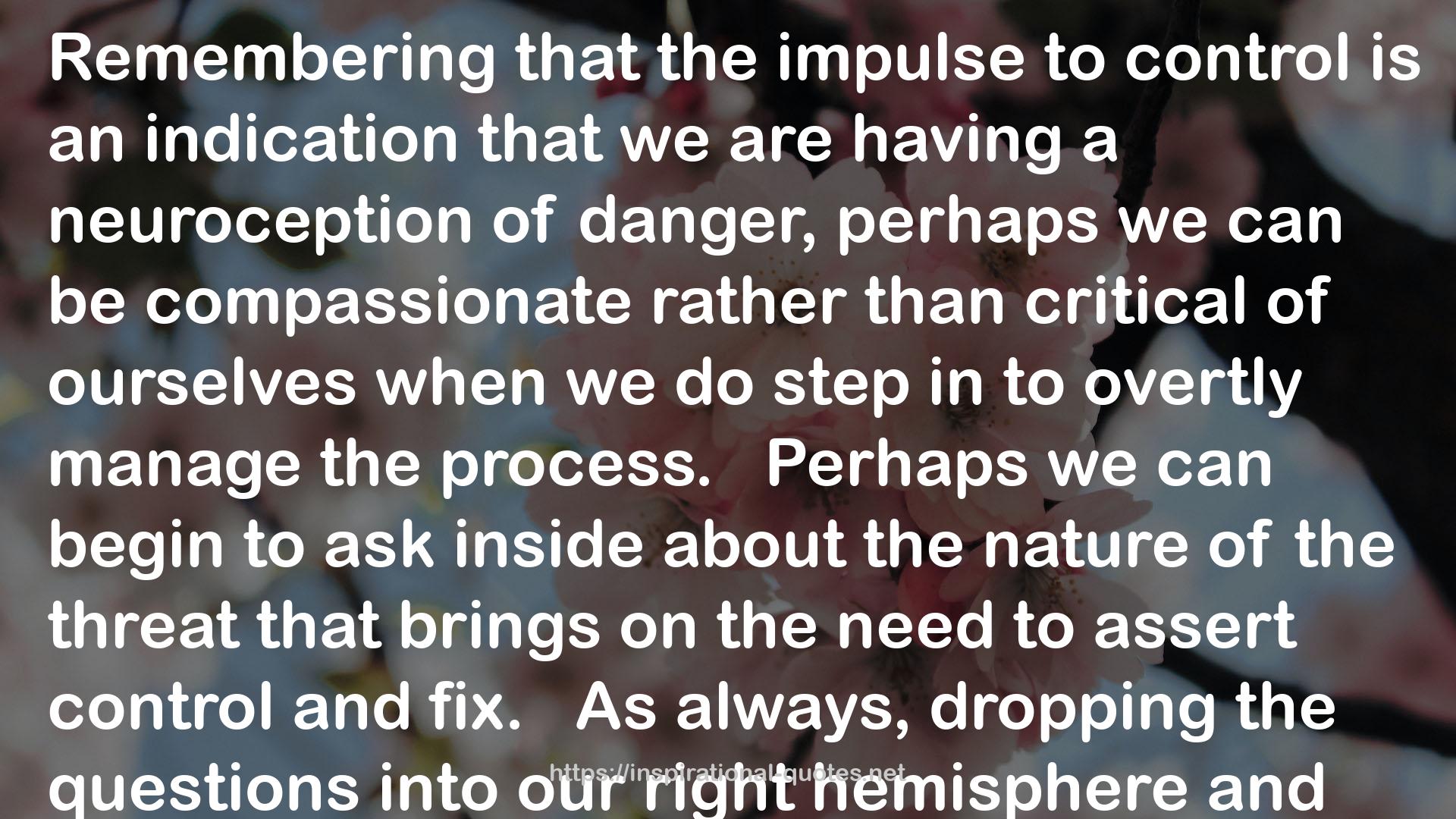84
" We may find ourselves in a role similar to that of a gardener as we cultivate a space in which healing can naturally unfold.
In terms of neurobiology, this stance encourages us to lean into the reassuring awareness that our systems already contain seeds awaiting our attention.
For some examples, we humans are always seeking the warmest possible attachments we can imagine (Cozolino, Siegel), our brains are continuously yearning for the arrival of a co-organizing other (Badenoch, Cozolino, Schore), emotional regulation flows naturally from being in the presence of someone we trust (Beckes & Coan) and even our nervous systems have a preference for the social engagement circuitry that sustains connection (Porges).
With this kind of support from the biology inherent in both practitioner and patient, our bodies may begin to open into a welcoming state as others come towards us, with a sense of partnership being established rather than someone doing something to us.
However this also means letting go of the potential certainty that comes from feeling we are in charge. "
― , The Heart of Trauma: Healing the Embodied Brain in the Context of Relationships
89
" My multifaceted canary in the coal mine signaling the impulse to control is my belly tightening, my posture changing slightly to lean forward, tension increasing in my upper arms. It feels as though I am preparing to thrust myself into the middle of the problem with everything I know. It comes from a good-hearted place of wanting to relieve suffering and also diminishes interpersonal safety as my system enters mild to medium sympathetic arousal.
If we take a step back, we might become curious about how the neuroception of danger arose in the first place, because that is what initiates this chain of events. If we were to explore this, many answers might come: We have been trained to intervene; we don't have any experience that tells us our patient's systems are trustworthy guides to healing; the upset in our patient is severe enough that we fear for her safety; if we can't heal this person, there's something wrong with us; strong emotions are uncomfortable for us and we need to regulate them before they overwhelm us.
The list is endless, individual and likely changes with each new circumstance. It is always a most valuable inquiry, especially if we can begin it with compassionate curiousity, which makes it less likely that we will feel shamed by the answer that presents itself.
When we remember that neuroception is an automatic adaptive process, it may take character condemnation out of the equation when we invite awareness of what frightens us.
If our fear feels heard and acknowledged, there is some likelihood that our bodies will be able to find their way back toward receptivity. As we feel our own openness returning, we can be certain that this embodied change is also influencing our patient and the quality of the connection. "
― , The Heart of Trauma: Healing the Embodied Brain in the Context of Relationships
95
" For all of us, there are also likely times when therapy simply doesn't seem to move forward as we imagined it would.
At this crossroads, we often question ourselves or blame our patients.
Between what our culture requires and what we have experienced in childhood, we might go either direction.
We have a particular challenge to feeling competent right now. Our left-centric society has done its best to codify the healing process, leaving us with a set of procedures and expected outcomes that don't welcome the individuality of our people of the fluidity of each person's unpredictable and unique process of recovery. This is doubly difficult, because when we follow the course culture provides, safety is already undermined to a greater or lesser extent.
I believe it wounds us when we feel we aren't helping a person because we set out with such good hearts to relieve suffering.
A well-practiced practitioner might try to guard our hearts by blaming our people's resistance.
When a wounded part of us is afraid we are inadequate, this often generates a critical protective voice to try to urge us toward a better performance.
In both instances, our ability to be present for our people gets lost in the need to protect.
How can we hold these experiences kindly, recognizing that they are part of the human experience?
Right now, we might be able to open the arms of inclusion to these parts of us. "
― , The Heart of Trauma: Healing the Embodied Brain in the Context of Relationships
99
" How might language separate us or draw us together? If our words center around grasping, creating, using, knowing, efficiency, step-by-step procedures, problem-solving, interventions, tools, and a sense of good-better-best (an ever-upward trend), we are likely attending mostly from a left hemisphere that is operating more or less autonomously, without support from the right's perspective. There is often a sense of judgement and certainty, along with an intent to guide, shape or control another that arises from and is reflected in this way of speaking. Because the left hemisphere has a tendency toward either/or, good/bad distinctions, there is often the sense of preference or wanting to get rid of something in favor of something else (ie: getting rid of sadness in favor of happiness or peace). "
― , The Heart of Trauma: Healing the Embodied Brain in the Context of Relationships

